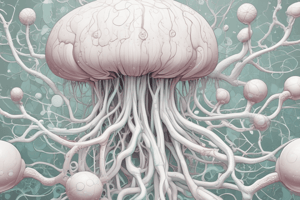Podcast
Questions and Answers
What are the functions of the lymphatic system?
What are the functions of the lymphatic system?
The functions of the lymphatic system include collecting and returning interstitial fluid to maintain fluid balance, defending the body against disease by producing lymphocytes, and absorbing lipids from the intestine and transporting them to the blood.
What are the components of the lymphatic system?
What are the components of the lymphatic system?
The components of the lymphatic system include lymph, lymphatic vessels (capillaries, vessels, trunks, ducts), lymphatic organs (thymus, lymph nodes, spleen, tonsils), and lymphatic cells.
What is lymph and how does it flow?
What is lymph and how does it flow?
Lymph is tissue fluid (interstitial fluid) that enters the lymphatic vessels. The flow of lymph starts from interstitial spaces to lymphatic capillaries, then to lymphatic vessels, lymph nodes, collecting duct, lymphatic trunk, and finally to the subclavian vein.
How does the lymphatic system help maintain normal blood volume and pressure?
How does the lymphatic system help maintain normal blood volume and pressure?
What is the role of lymphocytes in the lymphatic system?
What is the role of lymphocytes in the lymphatic system?
Flashcards
Lymphatic system function
Lymphatic system function
Collects and returns interstitial fluid, fights disease, absorbs lipids from the intestine.
Lymphatic system components
Lymphatic system components
Lymph, vessels (capillaries, vessels, trunks, ducts), organs (thymus, nodes, spleen, tonsils), cells (lymphocytes).
Lymph flow path
Lymph flow path
Interstitial fluid -> lymphatic capillaries -> lymphatic vessels -> lymph nodes -> collecting ducts -> subclavian vein.
Lymphatic system and blood volume
Lymphatic system and blood volume
Signup and view all the flashcards
Lymphocyte role
Lymphocyte role
Signup and view all the flashcards




